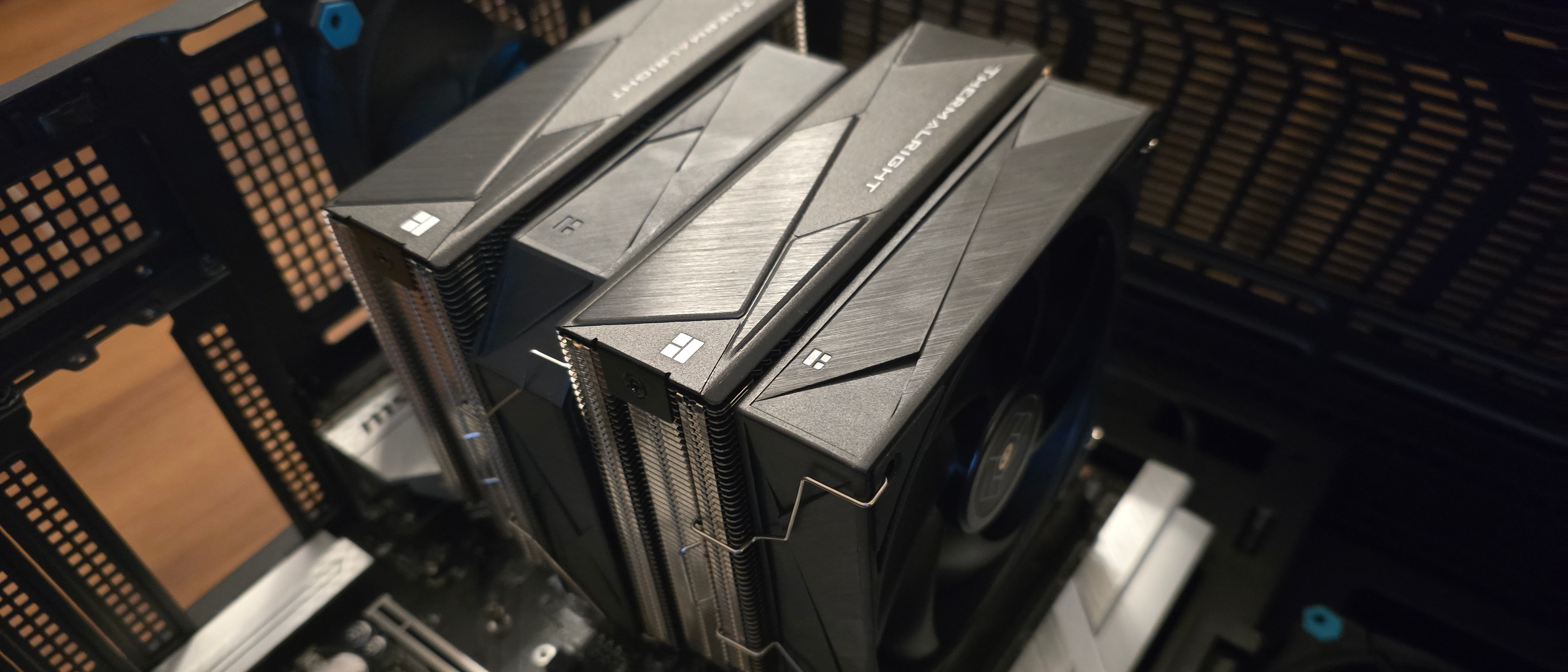Why you can trust Tom's Hardware
Noise Normalized CPU-only thermal results
Finding the right balance between fan noise levels and cooling performance is important. While running fans at full speed can improve cooling capacity to some extent, the benefits are limited and many users prefer a quieter system. Many consider these tests to be the most important of all, so we’ll start today’s review by looking at noise-normalized performance.
We’ll be looking at two different, distinct tests. We’ll first look at our traditional noise-equalized results with Intel’s i7-14700K, which places a full CPU load with the cooler’s noise levels set to 38.9 dBA.
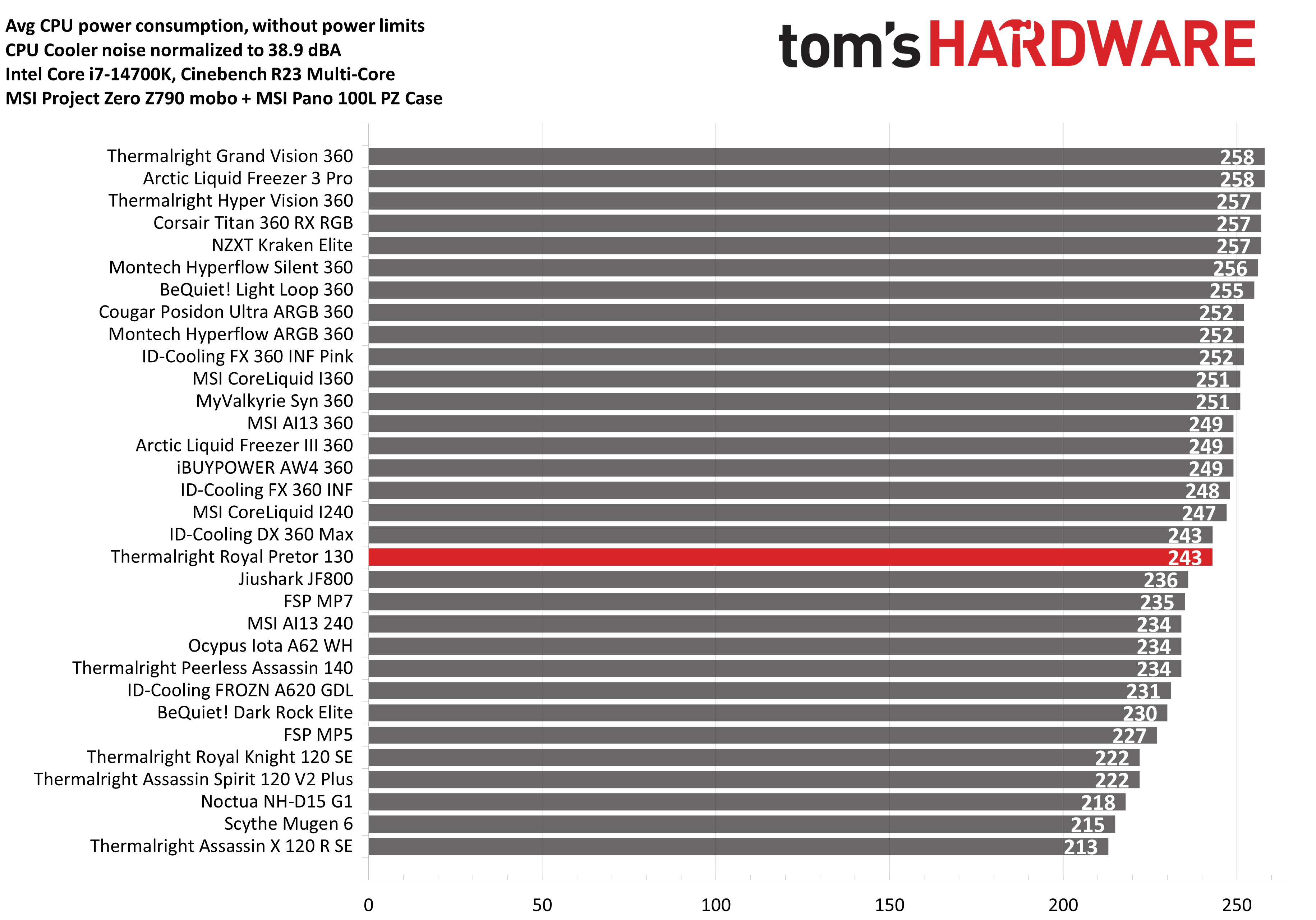
The performance of Thermalright’s Royal Pretor 130 was astounding on htis test, blurring the line between air and liquid coolers, with 243W cooled during this test – on par with ID-Cooling’s DX360 Max, a budget 360mm AIO. This is a full 7 W better than the best results we’d previously seen with an air cooler, from Chinese manufacturer Jiushark’s JF800 which cooled 236W in the same scenario.
Now let’s take a look at our noise-equalized tests utilizing AMD’s Ryzen 9 9950X3D CPU. Two changes (in comparison to our first test) have been made to increase the difficulty of this challenge. The noise level of the CPU coolers has been reduced to 37.3 dBA, and I’ve also run a full load on MSI’s RTX 4070 Ti Super GPU at the same time to increase the difficulty of this benchmark.
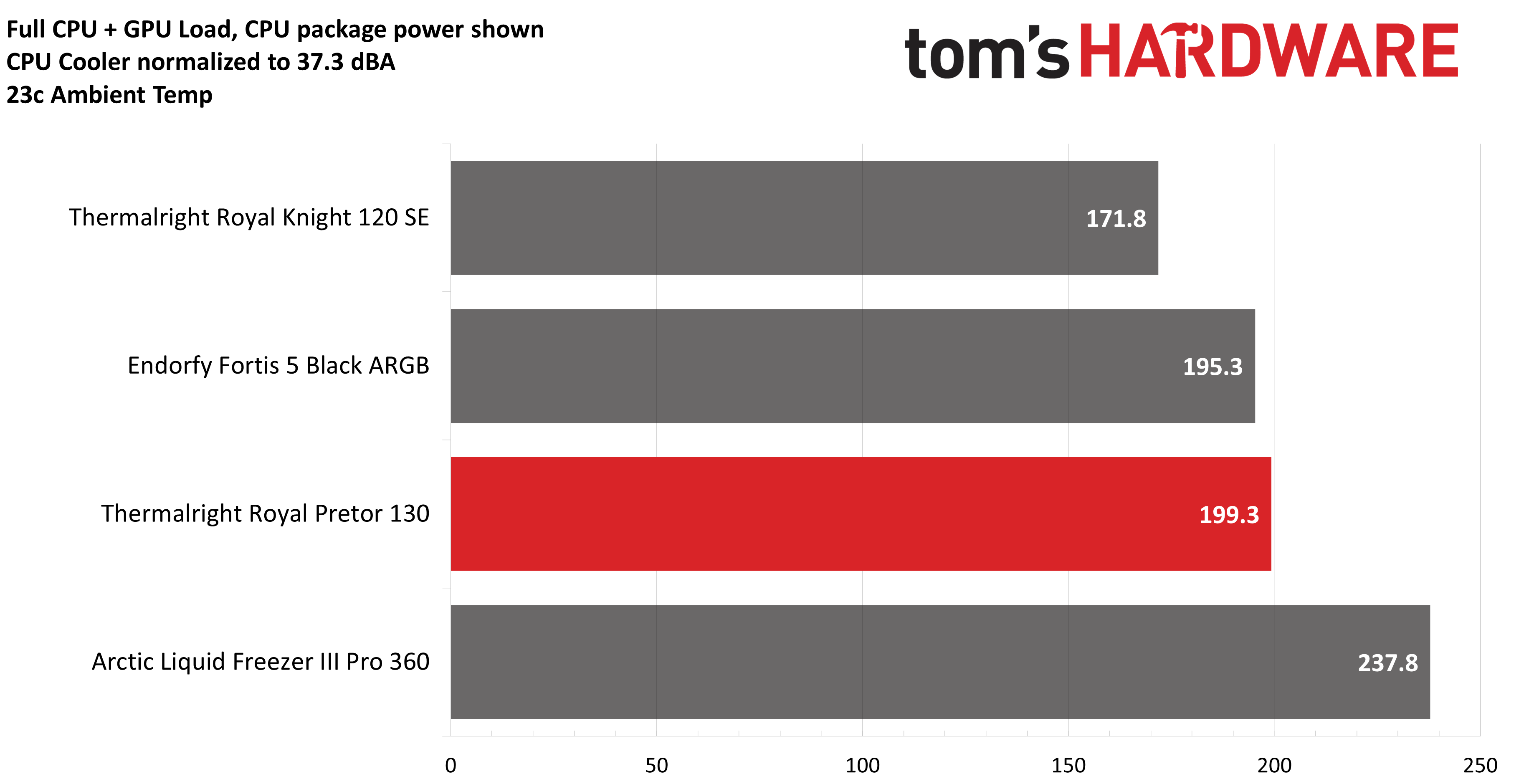
At this moment, I only have a limited amount of data for this noise-equalized test with AMD’s Ryzen 9 9950X3D – so I’m hesitant to make definitive judgments based on these four results. With that disclaimer out of the way, this test has the heat of a GPU added to it, makes it more difficult than typical CPU cooler tests. And yet, Thermalright’s Royal Pretor 130 still managed to cool over 199W! What this means is that this air cooler will also be strong enough to handle the full heat of AMD’s CPU (at stock settings, this CPU does not consume more than 200W), even with low noise levels – if you’re running typical CPU workloads.
CPU-only thermal results with PBO enabled: AMD Ryzen 9 9950X3D
Without power limits enforced, the hottest CPUs on the market will hit their peak temperature (TJ Max) and thermally throttle with even the strongest of air coolers and even most liquid coolers on the market in intensive stress testing. For the best liquid coolers on the market, the results of this test will be shown using the CPU’s temperature. However, when the CPU reaches its peak temperature, I’ve measured the CPU package power to determine the maximum wattage cooled to best compare their performance. It’s important to note that thermal performance can scale differently depending on the CPU it’s being tested with.
We’ll start by looking at the performance of this cooler with AMD’s newly released Ryzen 9 9950X3D CPU, with the disclaimer that I’ve only had a limited amount of time to test coolers with this system.
Get Tom's Hardware's best news and in-depth reviews, straight to your inbox.

The results on AMD’s Ryzen 9950X3D were very good. Thus far, I’ve only tested one cooler that can keep AMD’s flagship CPU under its peak temperature in a full-strength workload – Arctic’s Liquid Freezer III Pro!
Of these other coolers tested, Thermalright’s Royal Pretor 130 shows the best performance we’ve seen thus far, on par with the infamous Hyte THICC Q60 AIO!
CPU-only thermal results with power limits removed: Intel’s i7-14700K
Now let’s switch it up and take a look at how this cooler performs with Intel’s i7-14700K. The performance here is insane, matching many 360mm AIOs and almost able to handle the full heat of the CPU. Keep in mind that I test coolers at 23 degrees Celsius.
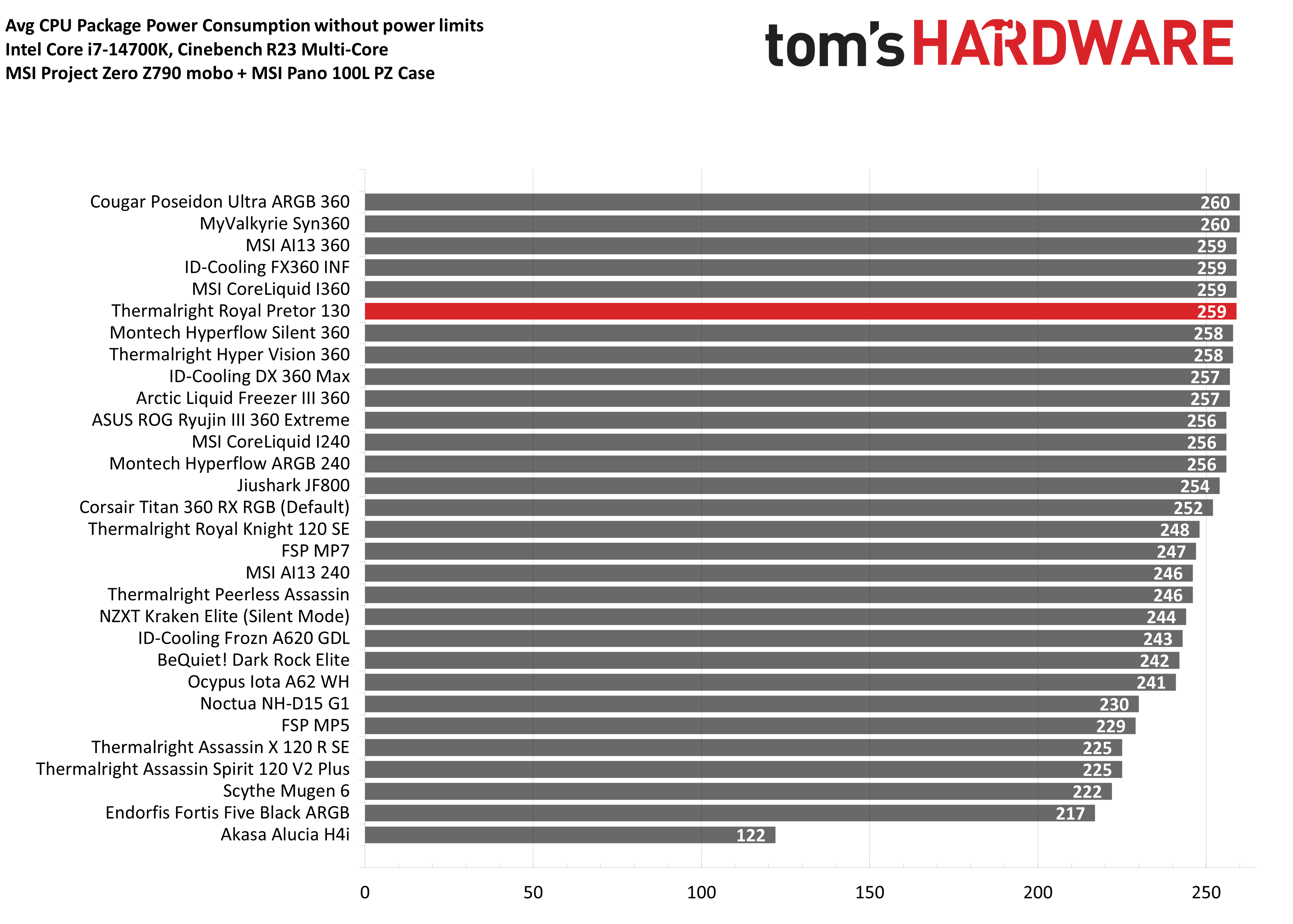
Maximum noise levels
A cooler’s maximum performance can’t be considered the only important metric, because some coolers run louder or louder than others. The maximum noise level this cooler operates at is 45.4 dBA. Most users will find this an acceptable volume, but some users might want to limit its speed if they are particularly sensitive.
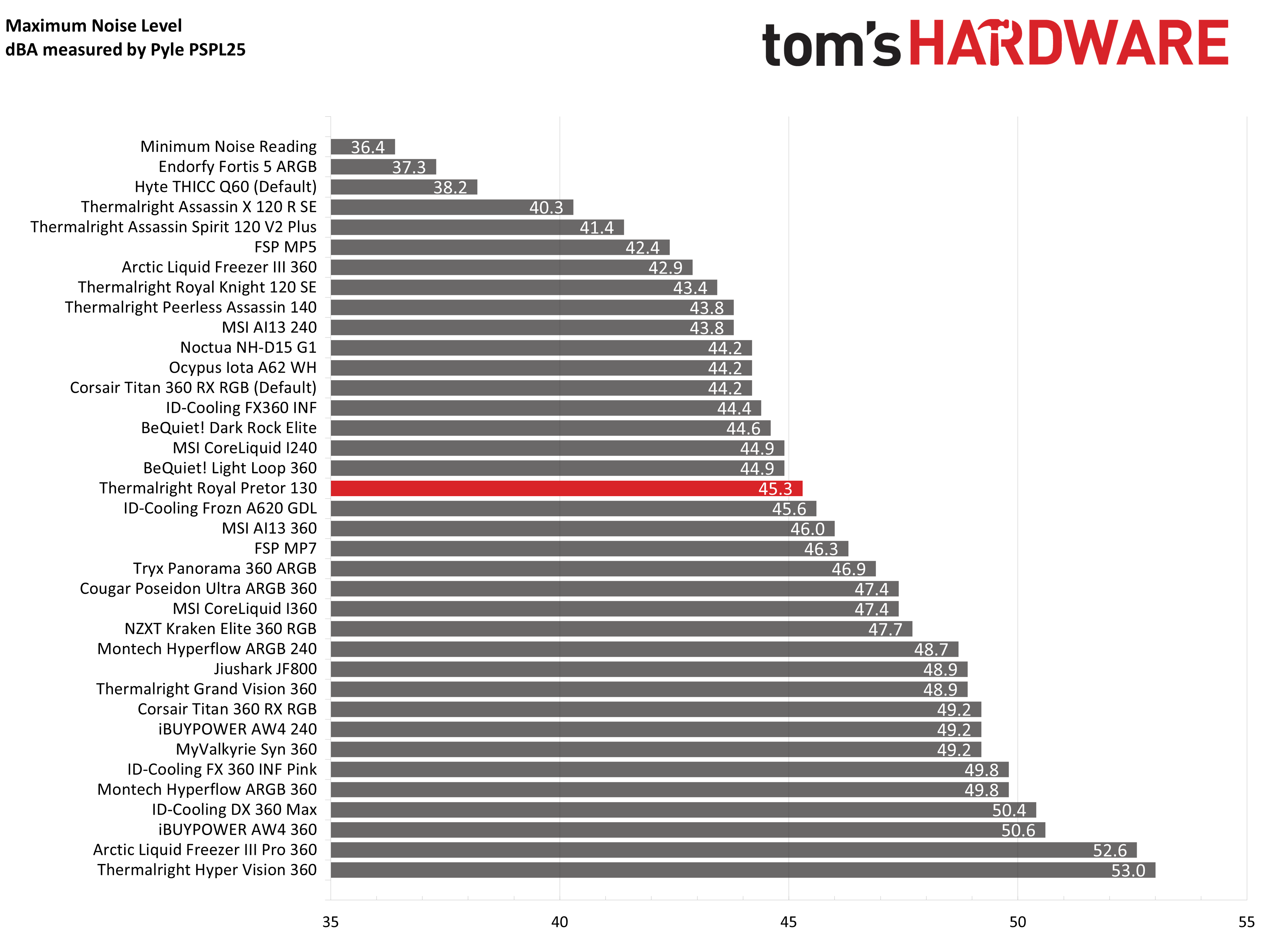
200W Power Limit
My recent reviews have focused more on tests with both the CPU and GPU being stressed, but many of y’all have indicated that you would like to see more CPU-only tests. Listening to that feedback, I’ve tested thermal and noise performance for AMD’s Ryzen 9 9950X3D at stock CPU settings – which limits power consumption to 200W.
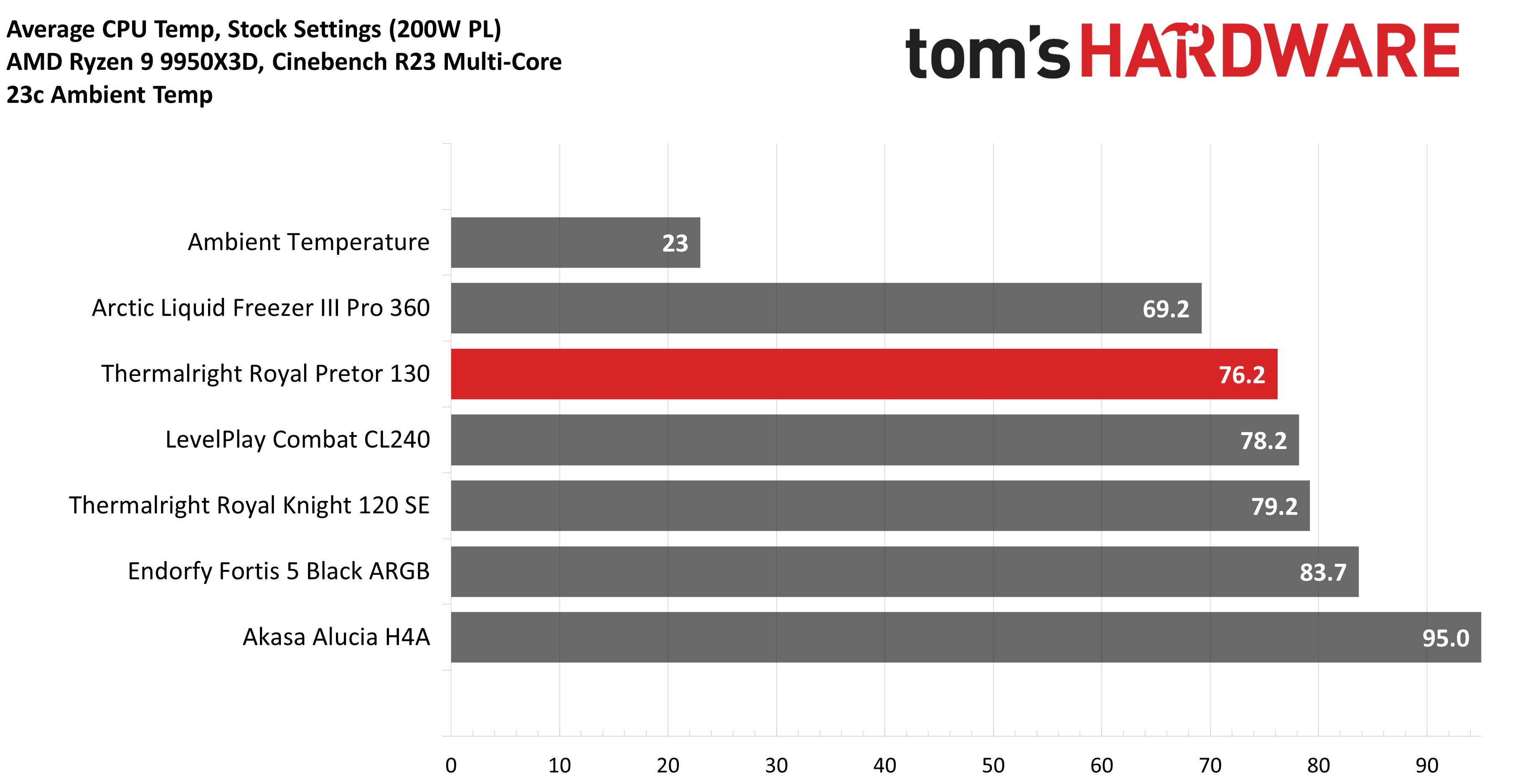
Thermalright’s Royal Pretor does very well at the CPU’s default power settings, outperforming a 240mm AIO from LevelPlay by two degrees. Noise levels are slightly reduced here compared to the previous tests, averaging 44.9 dBA.
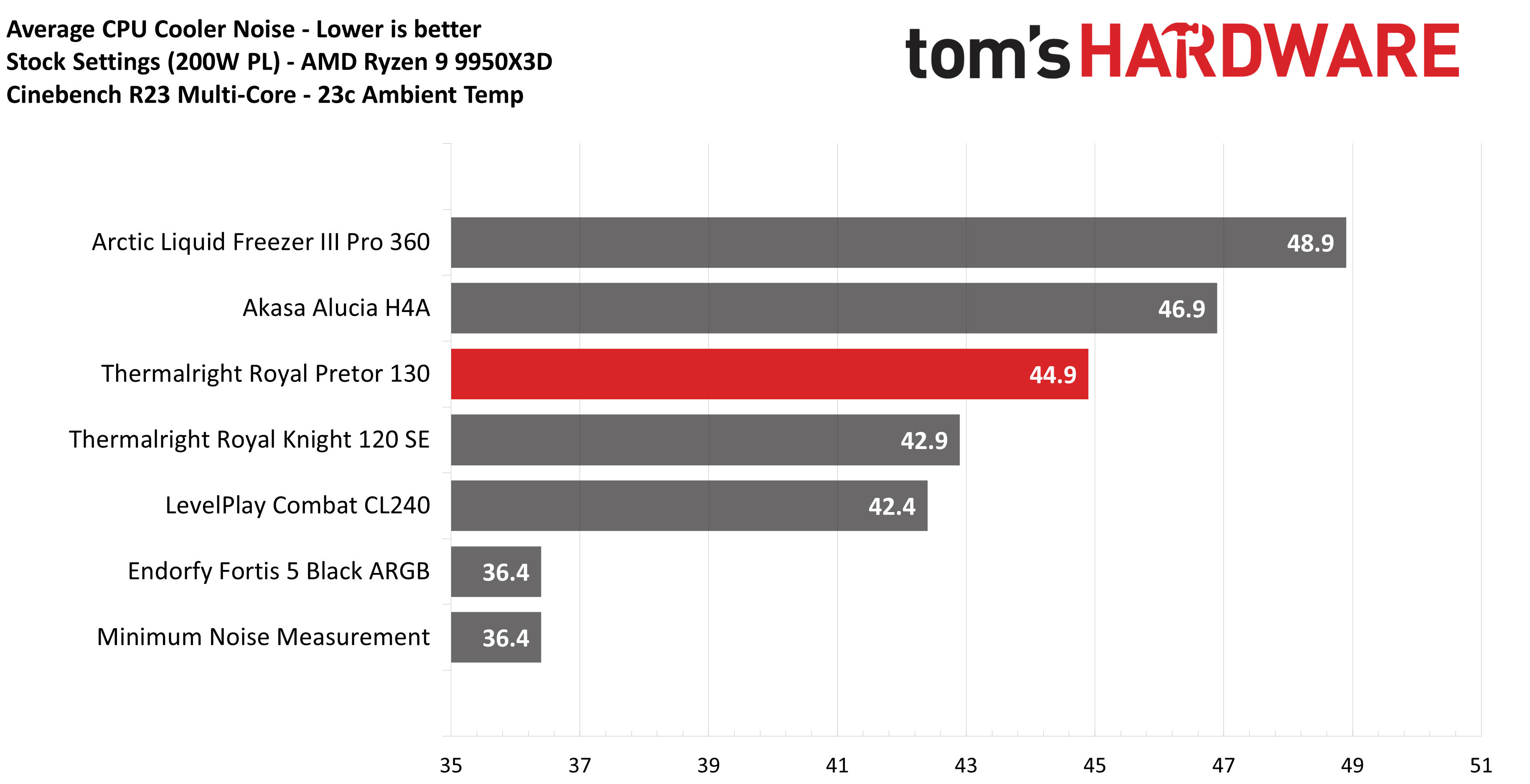
150W CPU + 290W GPU results
Testing a CPU Cooler in isolation is great for synthetic benchmarks, but doesn’t tell the whole story of how it will perform. If your GPU is running a full load, that heat doesn’t just disappear – it makes it harder for your CPU cooler to do its job due to the increased heat within your computer case.
The CPU power limit of 150W was chosen based on the worst CPU power consumption I’ve seen reported in gaming with AMD’s Ryzen 9 9950X3D. My personal experience tells me most games to use much lower amounts of power, but this might be biased by the games I play.

The results here are slightly flipped compared to our previous chart, with LevelPlay’s 240mm AIO taking a 3-degree lead ahead of Thermalright’s flagship air cooler. This is simply a reflection of the fact that when GPU heat is added to a workload, AIO coolers have a thermal design advantage that air coolers can’t quite overcome.
That said, the noise levels of the Royal Pretor 130 are very reasonable in this scenario, at only 40.9 dBA!
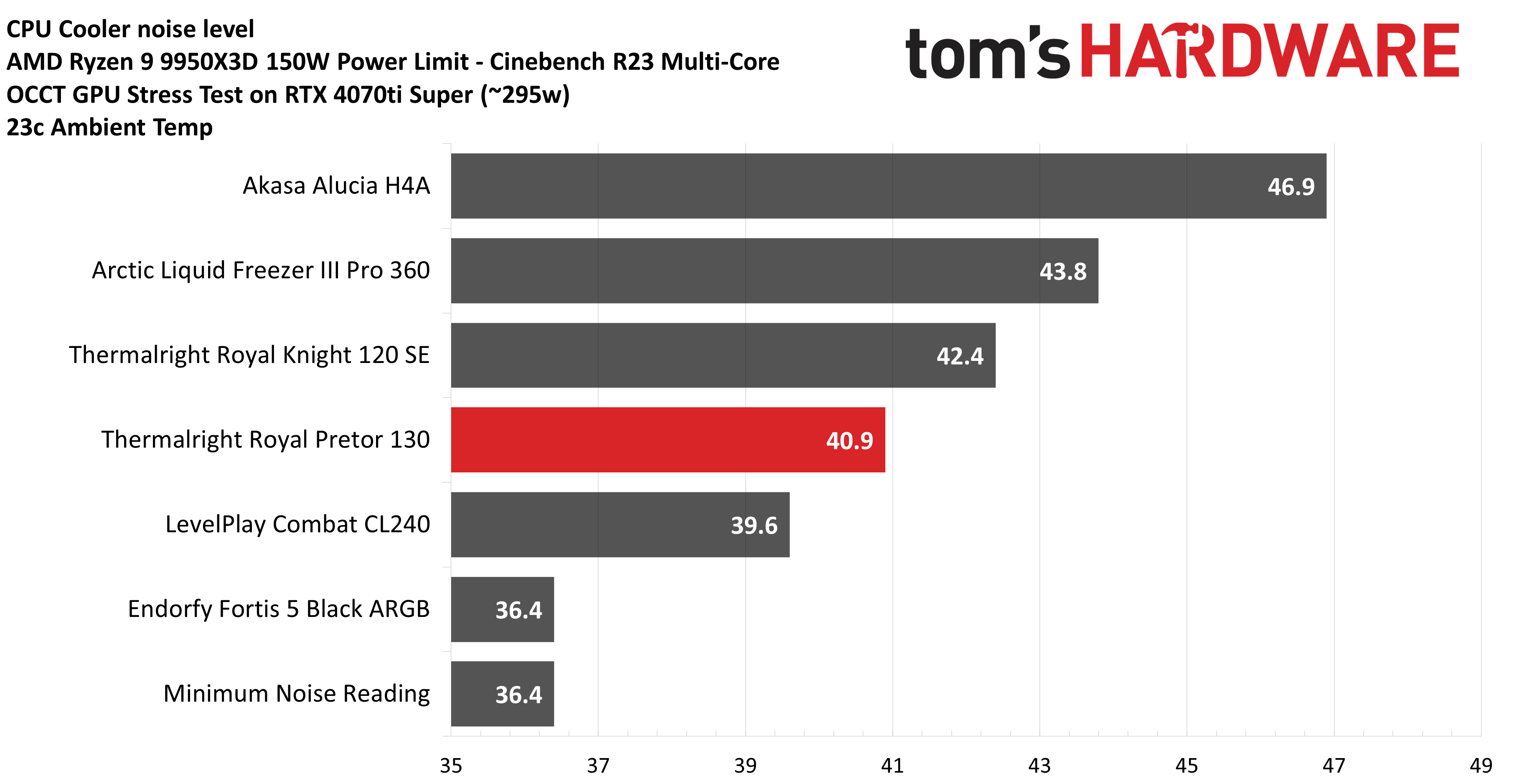
140W CPU results
The last round of test results we’ll look at in this review is a test with a 140W power limit imposed. This level of power is much easier for most CPU coolers to handle. As a result, this is the easiest test we’ll run with AMD’s Ryzen 9 9950X3D CPU for most reviews. But I’ve recorded lower power results for comparisons with SFF and air coolers for future reviews.
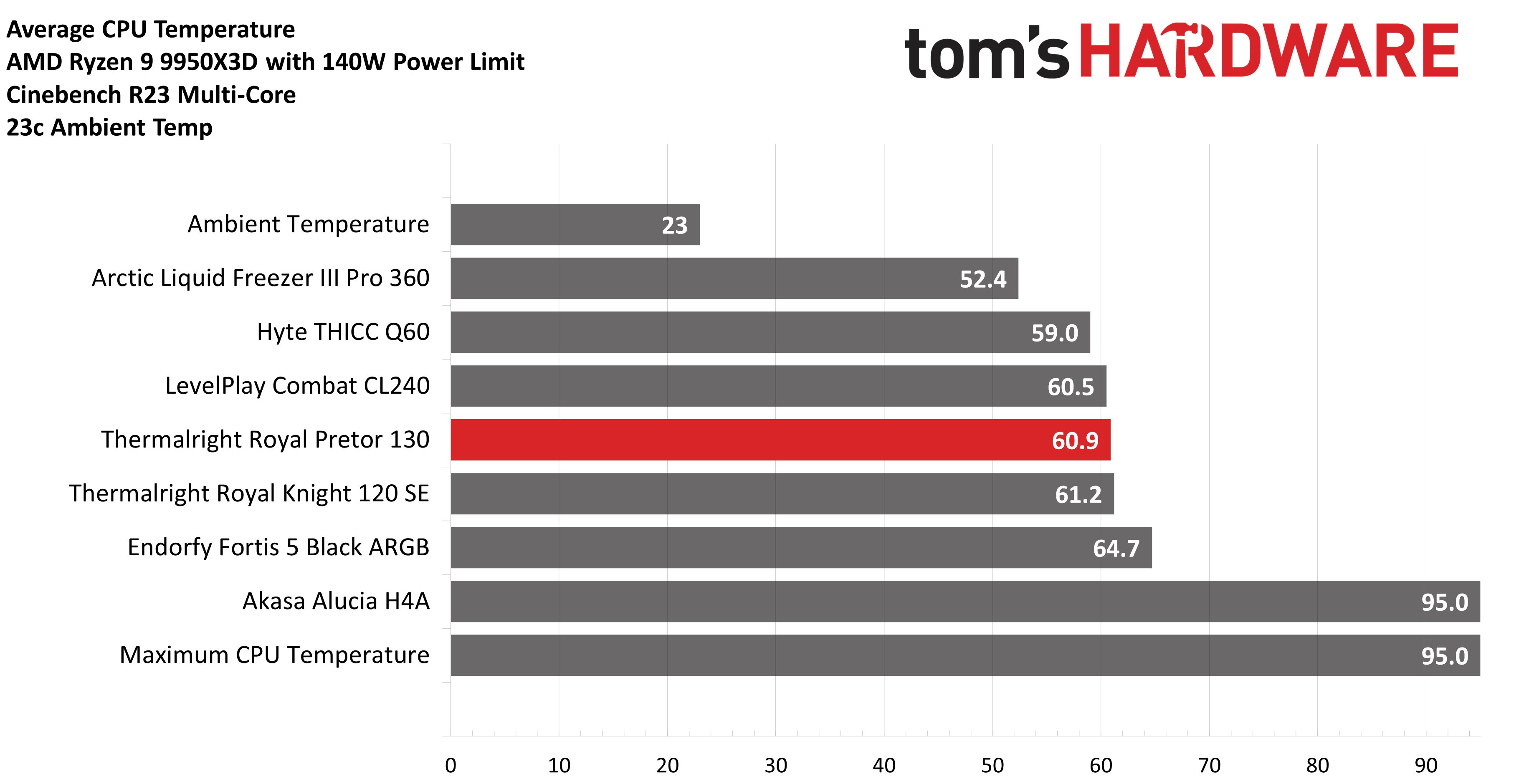
Thermalright’s Royal Pretor 130 kept the CPU at an average of 60.9 C in this scenario, which only stresses the CPU. Based on the results collected thus far, I expect most high-end cooling products to maintain a temperature similar to this.
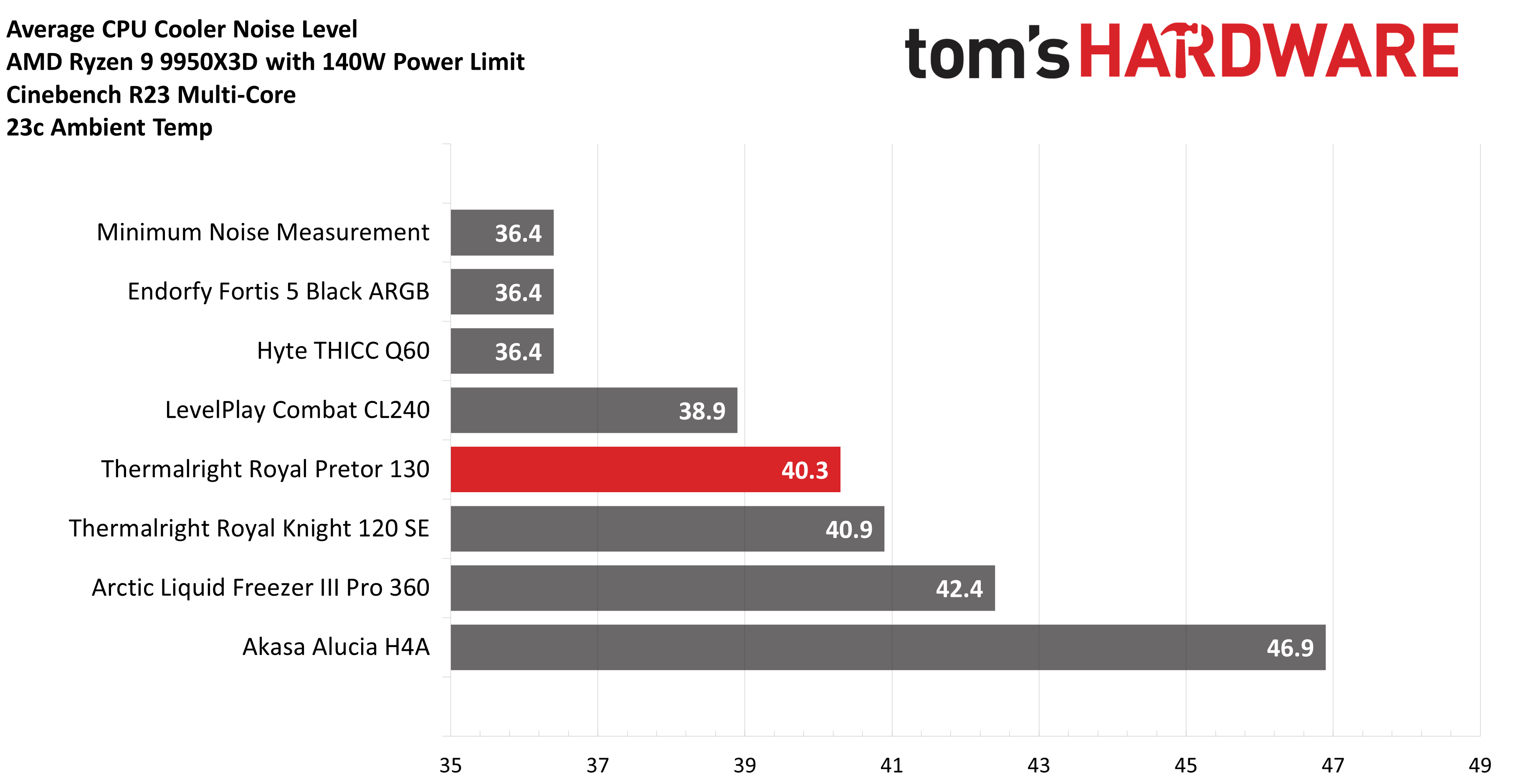
The noise level of the cooler is slightly reduced in this scenario, at 40.3 dBA. As a reminder, if you prefer the lowest noise levels, our noise-normalized results above show that this cooler performs excellently even when limited to 38.9 or 37.3 dBA.
Conclusion
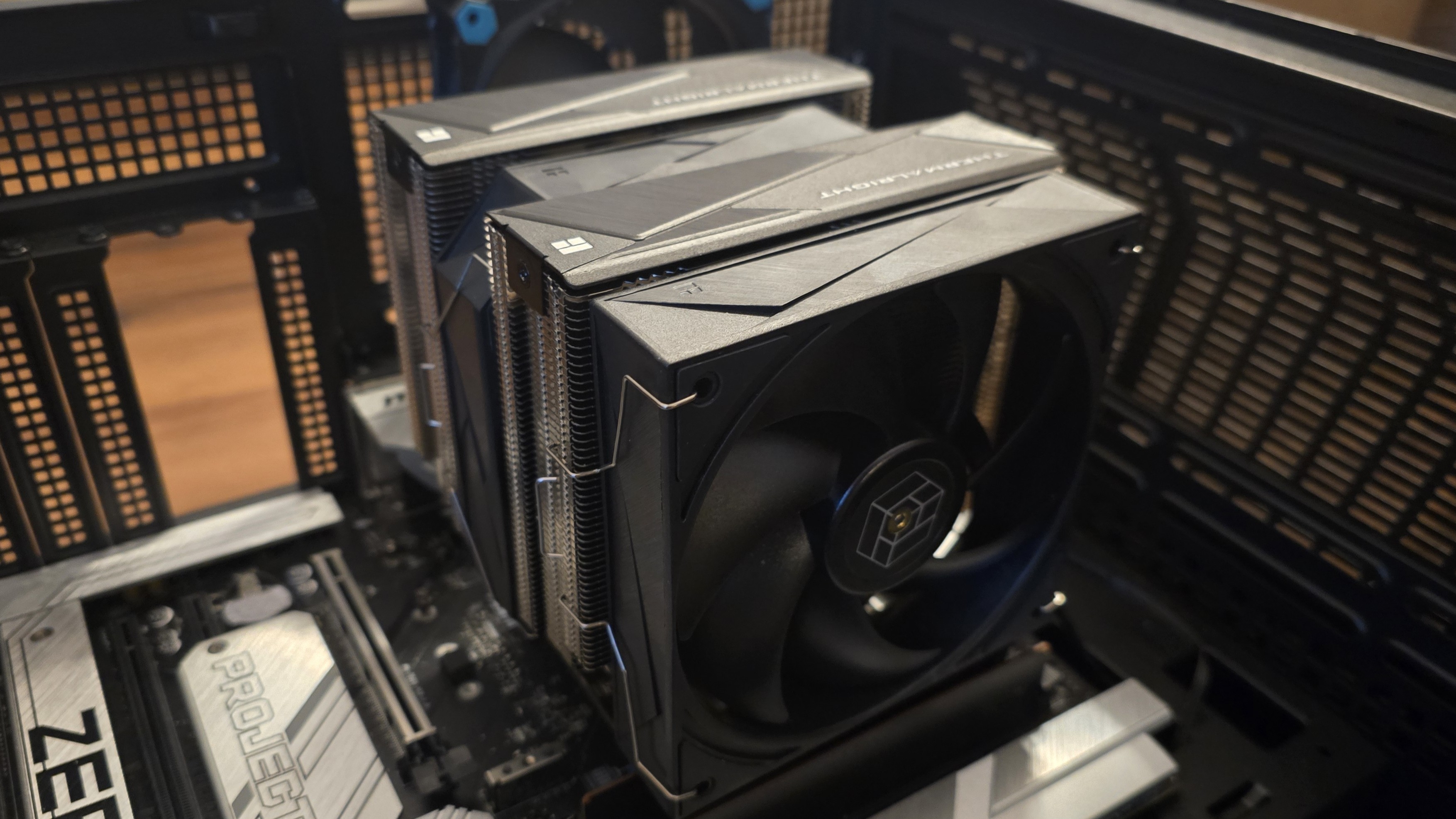
Thermalright’s Royal Pretor 130 shattered my expectations, raising the bar for what I consider possible with air cooling both in terms of maximum theoretical performance and when its fans are set to run quietly! The price of this cooler is extremely reasonable at only $52.90 USD, so if you’re looking for the best air cooler on the market, the Royal Pretor 130 is what you should buy.

Albert Thomas is a contributor for Tom’s Hardware, primarily covering CPU cooling reviews.
-
Roland Of Gilead Jeez, Thermalright are just knocking it out of the park with insane price performance for air coolers. The Phantom Spirit, Peerless Assassin and now this Pretor! Other companies should take a look at this and start producing the goods. And I don't mean a $100 Noctua.Reply -
Albert.Thomas Reply
I know, right? I don't know how they keep doing it!Roland Of Gilead said:Jeez, Thermalright are just knocking it out of the park with insane price performance for air coolers. The Phantom Spirit, Peerless Assassin and now this Pretor! Other companies should take a look at this and start producing the goods. And I don't mean a $100 Noctua. -
Krieger-San I'm confused why they claim this is the best cooler when there's no comparisons to the NH-D15 (Noctua). It's been in the top 5 best CPU coolers of all time.Reply
Also, does this beat the Thermalright Silver Arrow? It uses 8mm heat pipes, it beat the NH-D15 in many tests. -
2Be_or_Not2Be With these charts/graphics not allowing for zoom-in, it makes it hard to easily read all the names/numbers. I also don't know why we can't have increased/dynamic page width on these articles; the included charts could then be bigger by default as well. Most here have high-res screens, but it looks like these articles' page width is set to 800x600.Reply -
Albert.Thomas Reply
I had to move away from Arkansas earlier this year due to some pretty horrifying conditions, and I was only able to bring so many coolers when I moved.Krieger-San said:I'm confused why they claim this is the best cooler when there's no comparisons to the NH-D15 (Noctua). It's been in the top 5 best CPU coolers of all time.
That said, the Noctua NH-D1 is included on the Intel noise normalized results and on the maximum strength results.
That's a good question! I'm sure if Thermalright wants me to test it, they'll send a sample of this unit to me.Krieger-San said:Also, does this beat the Thermalright Silver Arrow? It uses 8mm heat pipes, it beat the NH-D15 in many tests. -
Albert.Thomas Reply
I'm not sure what is going on here, as the graphs I submit are of higher resolution, but I'll bring it up to management2Be_or_Not2Be said:With these charts/graphics not allowing for zoom-in, it makes it hard to easily read all the names/numbers. I also don't know why we can't have increased/dynamic page width on these articles; the included charts could then be bigger by default as well. Most here have high-res screens, but it looks like these articles' page width is set to 800x600. -
btmedic04 What is the maximum memory height supported without moving the fan up? I have a 7950x3d in a jonsbo D31 case, asus rog x670e gene and g.skill trident z neo ram and was initially looking at the phantom spirit evo, but my ram is a millimeter or two too tall to fit without raising the fan. If this can fit it without raising the fan, and has better performance to boot, then im all inReply -
Albert.Thomas Reply
What types of looks do you prefer?uplink-svk said:Cons:
- looks like 💩
- RAM clearance
